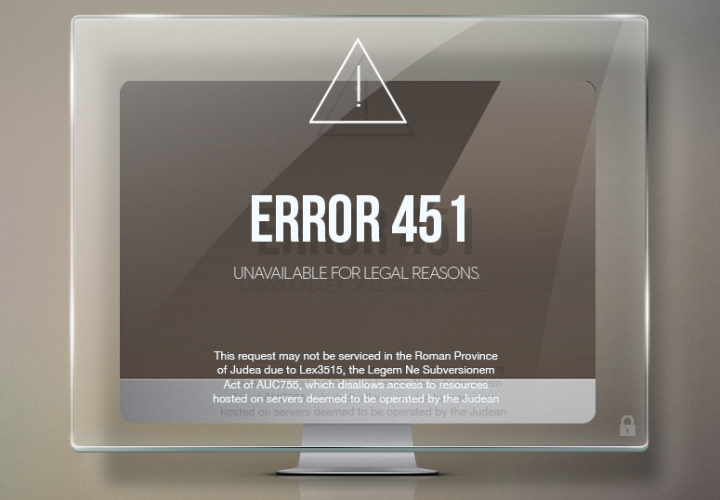
Any Web user is familiar with the 404 Page Not Found error message that appears on broken links. And some of us have happened upon the more mysterious ‘403 Forbidden’ error. But now, a digital rights group from the United Kingdom has launched a campaign this week to add yet another error message to the mix: ‘451 Unavailable,’ to be used anytime a webpage or website is blocked by a government for legal reasons.
Evoking the anticensorship message of late author Ray Bradbury’s famous novel Fahrenheit 451, the 451 Unavailable campaign is the brainchild of Open Rights Group (ORG), a U.K.-based public advocacy group that seeks to defend free speech and consumer rights on the Internet.
As the group explains on the 451 Unavailable website, governments may require Internet Service Providers to block access to certain websites for a variety of reasons. “In the UK, this is usually because the websites contain material that infringes copyright. In other parts of the world, websites are targeted for their political content,” ORG explains on the site. Currently, the 403 Forbidden message is often used in these instances, but the group believes this error fails to provide enough information to Web users when access is restricted by government demands.
The purpose of the 451 error is to explain to would-be visitors the exact reason a website or page is blocked. In addition to the error message itself, says ORG, a site blocked for legal reasons would ideally include “all the key information about the blocking order including links to the relevant court order, how to challenge the block and the law allowing the court to block websites in that country.”
While the 451 Unavailable campaign is new, the idea for a 451 error code to signify government censorship on the Web is not. In June of last year, Google developer Tim Bray first proposed the 451 error code, and went so far as to submit an official proposal to the Internet Engineering Task Force (IETF), which oversees the implementation of Web standards, including HTTP codes like 404 Page Not Found. The IETF was expected to consider Bray’s proposal last July, but has not yet approved its use.
In a message on Twitter, Bray tells us that he was not involved with building ORG’s website campaign, but is “smiling” at the effort. “I drafted the IETF proposal,” he writes. “Hadn’t seen the site, but smiling.”
According to ORG campaigner Ed Paton-Williams, “the 451 Unavailable campaign promotes the Error 451 code proposed by Tim Bray.” If the IETF approves Bray’s proposal, ORG sees the 451 error “being implemented by ISPs and search engines,” Paton-Williams told Digital Trends.
The IETF did not immediately respond to our request for comment on the status of Bray’s 451 proposal.
The ‘451 Unavailable’ campaign comes amidst heated debate in the U.K. over a government plan to force ISPs to block access to pornographic websites and material, unless a subscriber explicitly opts out of the porn filter. The U.K. government has already instituted a widespread block on we bites, like The Pirate Bay, which allow users to download copyrighted content illegally. According to a recent PC Pro report, the anti-piracy filter has led U.K. ISPs Virgin Media and Sky to inadvertently block access to legitimate news websites, including Radio Times and TorrentFreak.
If implemented, the 451 error code would not only be available for use by ISPs in the U.K., but also those worldwide.
ORG is currently asking legal experts, ISPs, Web developers, and the general public to help in the 451 campaign.


